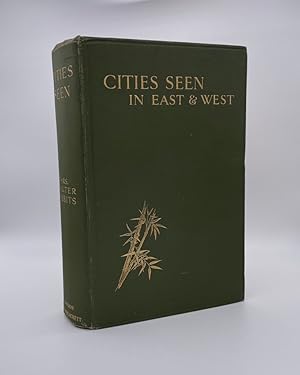Beschreibung
FIRST EDITION. Large 8vo, pp. xix, [1], 338 + 34 b/w plates. Original green cloth, spine and upper board lettered in gilt, gilt-stamped bamboo motif to upper board. Top edge gilt. Bruising and wear to spine ends and corners, spine rubbed. Photograph showing two women in nursing uniform, inscribed with: "May Lamington & Grisell," tipped in to front pastedown, light offsetting to ffep, plus PO inscription in sepia pen and the same hand: '"Each of us has so much to give/ that we never meet in Vain, and/ so much to receive that we part/ with thanks" - Carmen Sylva.' Newspaper clipping, 'Scottish Society Wedding,' announcing the marriage of Grisell and Lieutenant-Commander Hastings at Lamington Chapel laid in. Foxed, else, clean and tight. A pleasing copy of Tibbits' genre-crossing second book. Jisc LHD lists eight British and Irish holdings (BL, Bodleian, UoCambridge, UoExeter, NLW/LGC, NLS, UoSwansea & TCD) Despite having some significance to the theosophical movement in India a Mrs Walter Tibbits Memorial Library was erected in Benares the Anglo-Irish Hindu-convert is almost wholly absent from popular histories of Theosophy. Like Annie Besant and Bertram Keightley, Cathlyn Pepper Tibbits studied under Gyanandra Nath Chakravati, and published a number of travelogue-cum-theosophical treatises, which were widely reviewed, as well as writing a series for the Canadian Theosophist. Yet, the dates of her life remain elusive (and even her first names appear blurry: she is also listed at 'Kate Ellen' in library catalogues); the mask of 'Mrs Walter Tibbits' only slips here to reveal that she is a descendent of the Peppers of Ballygarth: the topic of her first chapter. Cities Seen is a book of two distinct and, apparently, divisive halves. In her scathing review, Annie Besant critiques Tibbits' "slip-shod English," notes her indebtedness to Ouida, in both style and the interest in "princes, duchesses and countesses scattered over the pages like pepper on a stew", but then changes gear: "[b]ut Ouida, while fond of sensual heroes, was not so fond of unclean innuendoes as to the most revolting bye-ways of human sin as is the writer of this book". What is worse, for Besant, is the tethering of the first half to its spiritual second, set in India: "It is a pity, alike for the authoress and her friends, that this book has been written. It is an outrage that Parts I and II should be bound in the same volume" (Besant, 1912). While more sarcastic than savage, The Athenaeum reviewer agrees, on the whole, with Besant (even down to their use of "slip-shod"), but hints at the queer-tinged and satanic "bye-ways" that await the reader. They conclude, less dramatically: "Her photos are excellent; index there is none." While Besant and Tibbits were acquainted through the Theosophical movement, the connection with the Lamingtons is unclear, but was most likely through India, where Tibbits lived, and Lady Mary Lamington's husband, the 2nd Baron Lamington, was Governor of Bombay (1901-1907). Lady Mary 'May' Lamington (1869-1944) trained as a nurse and served in a women's ambulance unit at the French front in WWI. During her earlier life in Australia, where her husband was Governor (1896-1901), May Lamington was instrumental in establishing the Lady Lamington Hospital for the Diseases of Women, as well as the Lady Lamington Nurses' Home at Brisbane General Hospital. The Hon. Grisell Cochrane-Baillie (1898-1985) was their only daughter. Annie Besant, (1913) 'Cities Seen Review', The Theosophist, Vol. XXXIV, part I, p. 626; Anon (1912) 'Cities Seen Review,' The Athenaeum, no. 4431 (28 Sept), p.336. Bestandsnummer des Verkäufers 2293
Verkäufer kontaktieren
Diesen Artikel melden
![]()

